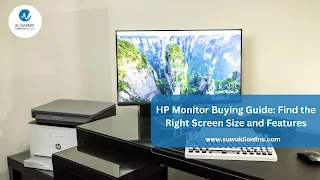HP Monitor Buying Guide: Find the Right Screen Size and Features
This comprehensive guide will help you navigate through screen sizes, resolution types, refresh rates, and other key
1. Understand Your Purpose
Before choosing an HP monitor, identify how
For Work/Office Use: Look for screens that offer clear text, wide viewing angles, and eye comfort technologies.
For Creative Work (Photo/Video Editing): Focus on color accuracy, screen resolution, and panel type.
For Gaming: Prioritize refresh rate, response time, and adaptive sync technologies.
For General Use: A balanced monitor with decent resolution, size, and comfort features should suffice.
2. Choose the Right Screen Size
Size matters, especially
21"–24" Monitors: Best for small desks and basic computing tasks such as browsing,
emailing, and word processing.25"–27" Monitors: Ideal for multitasking, general productivity, and light creative work. These sizes offer more screen real estate without overwhelming your desk space.
28"–32" Monitors: Great for professionals, content creators, and serious multitaskers.
The larger size makes it possible for multiple windows and detailed visuals to be viewed. 34” Ultra-Wide Monitors: Excellent for gamers, designers, or financial analysts who need to view multiple windows or timelines at once.
When deciding
3. Understand Resolution Options
Resolution impacts how sharp and detailed your images appear. HP monitors come in several
Full HD (1920x1080):
Most common and budget-friendly resolution. Suitable for everyday use. Quad HD (2560x1440):
Provides a sharper visual experience than Full HD, making it an excellent choice for gaming and creative purposes. 4K Ultra HD (3840x2160): Best for professionals who need ultra-detailed visuals, such as video editors, CAD designers, or high-end gamers.
The higher the resolution, the clearer and more detailed the display, but it also requires a more powerful computer to handle the increased graphical load.
4. Panel Types Explained
The type of panel a monitor uses
TN (Twisted Nematic): Offers the fastest response times, making it ideal for competitive gaming,
but has limited color accuracy and viewing angles.IPS (In-Plane Switching): Provides better color reproduction and wider viewing angles. Great for designers and general users.
VA (Vertical Alignment): Offers deep blacks and high contrast ratios, suitable for watching videos and casual gaming.
IPS panels are generally considered the
5. Look at Refresh Rate and Response Time
These features are especially important for gaming and video playback:
Refresh Rate (Hz): Measured in hertz, this tells you how
often your monitor updates the image.60Hz is standard, but for gaming, look for 120Hz or 144Hz.Response Time (ms): Indicates how quickly
pixels change color. Lower numbers mean less motion blur, ideal forquick games or videos. Aim for 1–5 ms for smooth visuals.
6. Check Connectivity Options
Modern HP monitors come with a range of ports. Consider what you’ll
HDMI: Standard for most devices.
DisplayPort: Often preferred for higher resolutions and refresh rates.
USB-C: Ideal for
new laptops andsupports video, power, and data transferwith one cable.VGA:
Old technology, but still found in some office setups.
Check your computer's compatibility before choosing a monitor.
7. Consider Ergonomics and Design
A monitor isn’t just a screen, it’s part of your workspace.
Adjustable Stand: Look for tilt, swivel, pivot, and height adjustments to maintain a comfortable posture.
VESA Mount Compatibility: If you prefer a wall-mounted or arm-mounted setup.
Slim Bezels: Great for dual-monitor setups and modern aesthetics.
Eye Care Features: HP monitors often include blue light filters and flicker-free technology to reduce eye strain.
8. Energy Efficiency and Warranty
A monitor that consumes less
Conclusion
Choosing the right HP monitor depends on balancing your needs, space, and budget. Whether you're a gamer, a remote worker, a designer, or a casual user, understanding screen size, resolution, panel types, and additional features will help you make a confident and informed decision. Take your time, read the specs carefully, and select the monitor that best fits your daily routine and enhances your digital experience.
Contact Us:
🌐 www.suwaidionline.com
📱 +971 43988842
📩 onlineorder@suwaidillc.ae


.png)

Comments